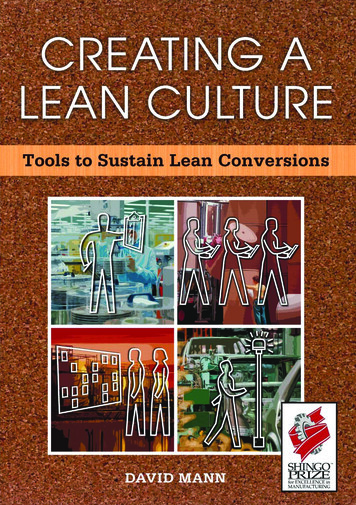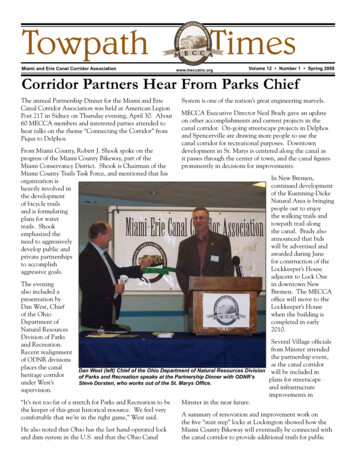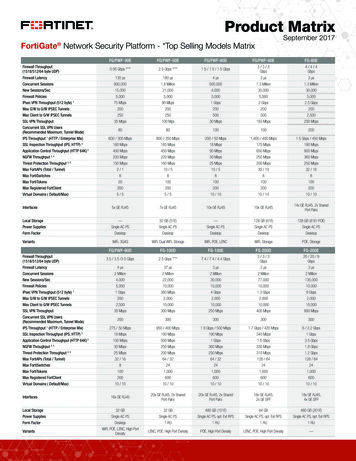
Transcription
Creating aLean CultureTools to Sustain Lean ConversionsDavid MannNew York
Copyright 2005 by Productivity Press, a division of The KrausOrganization LimitedAll rights reserved. No part of this book may be reproduced orutilized in any form or by any means, electronic or mechanical,including photocopying, recording, or by any information storage and retrieval system, without permission in writing from thepublisher.Most Productivity Press books are available at quantity discounts when purchased in bulk. For more information contactour Customer Service Department (888-319-5852). Address allother inquiries to:Productivity Press444 Park Avenue South, 7th floorNew York, NY 10016United States of AmericaTelephone 212-686-5900Fax: 212-686-5411E-mail: rary of Congress Cataloging-in-Publication DataMann, David W. (David William), 1947Creating a lean culture : tools to sustain lean conversions /David W. Mann.p. cm.Includes bibliographical references and index.ISBN 978-1-56327-322-3 (alk. paper)1. Organizational effectiveness. 2. Industrial efficiency. 3.Organizational change. 4. Corporate culture. I. Title.HD58.9.M365 2005658.4'01—dc22200500598511 10 09 08 07 10 9 8 7 6
TABLE OF CONTENTSTable of ContentsIntroduction . . . . . . . . . . . . . . . . . . . . . . . . . . . . . . . . . . . . . . . . . . . . . . . . .vAcknowledgments . . . . . . . . . . . . . . . . . . . . . . . . . . . . . . . . . . . . . . . . . . . .ixPart 1: What Is the Lean Management System?Principal Elements of Lean Management . . . . . . . . . . . . . . . . . . .1Chapter 1: The Missing Link in Lean: The Management System . . . . . . . .3Chapter 2: The Lean Management System’s Principal Elements . . . . . . . .19Chapter 3: Standard Work for Leaders . . . . . . . . . . . . . . . . . . . . . . . . . . . .25Chapter 4: Visual Controls . . . . . . . . . . . . . . . . . . . . . . . . . . . . . . . . . . . .39Chapter 5: Daily Accountability Process . . . . . . . . . . . . . . . . . . . . . . . . . .69Part 2: Learning Lean Management and Production:Supporting Elements of Lean Management . . . . . . . . . . . . . . . . .89Chapter 6: Learning Lean Management: The Sensei and Gemba Walks . .91Chapter 7: Leading a Lean Operation . . . . . . . . . . . . . . . . . . . . . . . . . . .101Chapter 8: Solving Problems and Improving Processes—Rapidly . . . . . .119Chapter 9: People—Predictable Interruption; Source of Ideas . . . . . . . . .137Chapter 10: Sustain What You Implement . . . . . . . . . . . . . . . . . . . . . . .157Appendix . . . . . . . . . . . . . . . . . . . . . . . . . . . . . . . . . . . . . . . . . . . . . . . .173Glossary . . . . . . . . . . . . . . . . . . . . . . . . . . . . . . . . . . . . . . . . . . . . . . . . . .191References . . . . . . . . . . . . . . . . . . . . . . . . . . . . . . . . . . . . . . . . . . . . . . . .203Index . . . . . . . . . . . . . . . . . . . . . . . . . . . . . . . . . . . . . . . . . . . . . . . . . . . .205About the Author . . . . . . . . . . . . . . . . . . . . . . . . . . . . . . . . . . . . . . . . . .213iii
DedicationTo my wife Jan and our daughters Kate and Elizabeth.Without your love, support, patience, and encouragementI could not have written this book.
INTRODUCTIONIntroductionCreating a Lean Culture addresses a gap in the literature on lean production andthe Toyota Production System (TPS). This book introduces a lean system formanagement, first in concept and then in concrete detail. Lean management is acrucial ingredient for successful lean conversions. Yet, the standard books on leaneither don’t cover it or only hint at implementing new ways to manage in a leanenvironment. Creating a Lean Culture provides the rationale and then a practicalguide to implementing the missing link you’ll need to sustain your lean implementation—a lean management system.Lean production, based on the much admired Toyota Production System,has proved to be an unbeatable way to organize production operations. The keyconcepts of lean are easily grasped, and relative to most technical engineeringprojects, lean designs are easily implemented. Yet the majority of attempts toimplement lean production end in disappointing outcomes, and declarationslike: “Lean won’t work here,” or “with our people,” or “in our industry,” or “withour product/process,” and so on.Why, when it seems so simple, are successful lean implementations so difficult to achieve? The answer is in an overlooked but crucial aspect of lean. Itrequires an almost completely different approach in day-to-day and hour-to-hourmanagement, compared to anything with which leaders in conventional batchand-queue environments are familiar or comfortable.I’m a social scientist, an organizational psychologist. By conventional measure, I’ve been in the “wrong” place for someone with my training and background for the past 15 years. It has turned out to be the right place though, to beimmersed in manufacturing operations and directly involved in supporting morethan 30 brownfield lean conversion projects, large and small. Through much trialand error in these experiences, I’ve come to recognize a common, but typicallyoverlooked, element in batch-to-lean conversions. This element is a lean management system. Not only is it necessary to sustain new lean conversions, it accountsfor the differences between failed and successful implementations.The book lays out the components of lean management, how they worktogether, and how to implement the process. Creating a Lean Culture maps acourse for leaders implementing lean management to guide them through thecultural minefields in batch-to-lean conversions.v
CREATING A LEAN CULTUREHow This Book Is OrganizedThe book is organized into two sections. Part I answers the question: What is thelean management system? This section details the principal elements of lean management and includes chapters 1 through 5, as summarized in the chart below:Principal Elements of Lean ManagementElementKey CharacteristicsChapterDetailsLeaderstandard workDaily checklists for line production leaders—team leaders,supervisors, and value stream managers—that state explicitexpectations for what it means to focus on the process.3Visual controlsTracking charts and other visual tools that reflect actual performance compared with expected performance of virtuallyany process in a lean operation—production and nonproduction alike.4DailyaccountabilityprocessBrief, structured, tiered meetings focused on performancewith visual action assignments and follow-up to close gapsbetween actual results vs. expected performance.5DisciplineLeaders themselves consistently following and following up onothers’ adherence to the processes that define the first threeelements.3-5Part II consists of chapters 6 through 10 and covers how you learn lean production, and especially, how you learn lean management. The approaches to each arenearly identical. Eight attributes are described for leading a lean conversion project and the important role played by these attributes in slightly—but importantly—different form when leading an ongoing lean production area. Part II alsocovers some supporting elements in the lean management system, including theaspects of lean management that focus on people-related issues. The followingchart lists these and coordinates them to specific chapters. Finally, Part II focuseson what to do to sustain the lean management and lean production systems youhave worked so hard (or will work so hard) to implement. In addition to guidance for leaders, this includes an audit of the lean management system that canbe readily adapted for use in your workplace.Throughout the book are dozens of highlighted case studies, to show youhow lean management and lean production work—or should work. And the bookis chock full of sample visual ideas, to jump start your brainstorming for whatmight work best in your own organization.vi
INTRODUCTIONSupporting Elements in the Lean Management SystemSupportingElementKey CharacteristicsChapterDetailsThe leadershiptasks in anongoing leanoperationSubtle, but important, differences between leading lean conversion projects and leading ongoing lean operations.6Learning leanmanagementWork with a sensei; use the production area as the classroomthrough gemba walks.7Root causeanalysisStandard, basic tools to focus on eliminating the causes ofproblems rather than settling for workarounds that leavecauses undisturbed.8Progressivediscipline ina leanenvironmentApplying discipline for performance as well as for conductas a source of support for expected performance in a leanenvironment.8RapidresponsesystemProcedures and technology for summoning quick help fromsupport groups and management is important in finely balanced lean operations. New relationships between supportgroups and production areas are an often-overlooked criticalfactor for successful “911” systems.8ImprovementprocessHow are improvement activities managed when they exceedthe scope of the daily task assignment boards?8AppropriateautomationIT networks can be powerful tools in support of lean production and lean management. Much of the power in IT for leanconsists of knowing when not to apply it.8LaborplanningA suite of four visual tools for planning the next day’s workassignments, rotation plan, and unplanned absences.9HR policiesChanges to pay plans, expectations for rotation, applying discipline for problem performers, break schedules, communication processes, grades pay and classifications, and other“people” issues that help or hinder a lean operation.9Assessing thestatus of leanmanagementA five-level assessment on eight dimensions of lean management to highlight areas needing attention to bring lean management practices up to a self-sustaining level.10,Appendixvii
CREATING A LEAN CULTUREWho Can Learn From This Book?This book is for you if you are a leader at any level in an organization undergoing a lean transformation. You could be an hourly leader of a production team, asupervisor of a department and team leaders, a value stream manager with supervisors and support group staff working in your value stream, or you could be anexecutive—a plant or site or manufacturing general manager; an operations, division, or corporate executive.This book is also for you if you or your organization is contemplating a leantransformation. You might not yet know much about lean production. There areseveral clearly written and readily available books and articles you can turn to foran introduction. See the references section at the end of this book, and if you’reunfamiliar with the terminology, scan the glossary too.You might be an engineer or other technical professional concerned aboutthose pesky humans who are likely to trip up your well-designed system. You willfind constructive ways of dealing with these issues here, too. Or, you might be asupport group manager with questions about the demands lean production willmake on you and your group.This book is also for you if you are wondering what the heck happened tothe last project you worked on, the lean project that seemed to hold such promise, but just did not turn out as you hoped it would.Perhaps least likely, you might be a social scientist interested in how manufacturing organizations undergo change and the conditions that either support orimpede it.Whoever you are, welcome and let’s go!viii
ACKNOWLEDGMENTSAcknowledgmentsI owe much to many people with, for, and from whom I have worked andlearned—bosses, clients, colleagues, sensei. I will try to acknowledge them here,and apologize to any I miss. Any shortcomings in this book are fully and exclusively my own responsibility.The Association for Manufacturing Excellence (AME) gave me access to awider professional audience than I could otherwise have had, and provided vehicles for reaching the larger manufacturing community.Steelcase, Inc. gave me the opportunity to experiment with and developmany of the ideas and approaches to lean management contained in these pages.At Steelcase, I had the good fortune to work for several executives who supportedthe idea that there had to be more to lean production than the application ofHenry Ford’s and Toyota’s industrial engineering techniques. Among them wereAdolph Bessler, Rob Burch, and especially Mark Baker. I am grateful to all ofthem.Mark Baker, Mark Berghoef, John Duba, and Scott McDuffee read earlydrafts of the manuscript and provided helpful critique and suggestions. I appreciate their willingness to take on this task and their thoughtful comments.I have had some terrific clients to work with while developing (actually, codeveloping) and testing the concepts and tools of lean management. Amongthem are Shanda Bedoian, Mark Berghoef, Dave Greene, Dave McLenithan,John Mancuso, Kevin Meagher, Didier Rabino, and Jane Velthouse.I learned a lot about lean thinking from sensei Tom Luyster and MarekPiatkowski and am thankful they shared their knowledge and perspectives with me.My colleagues on our lean journey have been important in helping developand refine much of what is in this book. Scott McDuffee, Pat Nally, Bob O’Neill,and Dave Rottiers all contributed to what has emerged as lean management. JohnDuba and Ken Knister have been constant sounding boards and valued collaborators over the years.Maura May of Productivity Press took a chance on the basis of a presentationat the AME conference in 2003 and provided welcome and needed encouragement throughout the writing process. Ruth Mills edited the manuscript andmade refinements that make the book more accessible to readers.Finally, I want to acknowledge and thank my first and primary editor, myspouse Jan, who taught me that everybody needs an editor, but probably does notrecognize that few ever get one as gifted as she.ix
Part 1What Is theLean Management System?Principal Elements of Lean Management
1The Missing Link in Lean:The Management SystemMost prescriptions for lean production are missing a critical ingredient: a leanmanagement system to sustain it. Lean management practices are like many otheraspects of lean: easy to grasp, but difficult to execute consistently. This book spellsout the distinction between an organization’s culture and its management system;provides a framework to see the differences between lean and batch cultures; anddetails the practices, tools, and thinking for establishing lean management. A leanmanagement system sustains and extends the gains from implementing lean production. Lean cultures grow from robust lean management systems, and thischapter shows how.Developing a Lean CultureWhat is culture? Is it real? Should it be among the targets in your lean implementation? As a working definition, consider culture in a work organization to be thesum of peoples’ habits related to how they get their work done. You will see several examples in the next few pages. Given that, culture must be “real,” right?Well, yes and no.In scientific language, culture is a hypothetical construct. That is, culture is alabel or idea—a concept we make up to organize and get a handle on what wehave seen or experienced. It has been said that something is real if it has observable effects. Culture certainly fits the bill there. People talk about their company’sculture all the time as a reason why they can or cannot do something. Keynote3
CREATING A LEAN CULTUREspeakers refer to an organization’s culture as enabling or inhibiting change orresistance. Annual reports proudly refer to company culture as an invaluableasset, and so on.Should a company target its culture in its efforts to transform its productionprocesses and all the positions—high and low—associated with it? It is temptingto answer: Yes! But, that would be a mistake.Culture is no more likely a target than the air we breathe. It is not somethingto target for change. Culture is an idea arising from experience. That is, our ideaof the culture of a place or organization is a result of what we experience there.In this way, a company’s culture is a result of its management system. The premise of this book is that culture is critical, and to change it, you have to changeyour management system.So, focus on your management system, on targets you can see, such as leaders’ behavior, specific expectations, tools, and routine practices. Lean productionsystems make this easier, because they emphasize explicitly defined processes anduse visual controls.Don’t Wait—Start Now!Do not wait for the “real work,” the physical changes of a lean implementationto be done before turning your attention to implementing the management system. Your lean implementation depends on it to survive! Think of it this way: insuccessful brownfield mass-to-lean conversions, no more than 20 percent of theeffort involves the typical “what you see is what you get” physical changes. Youinstall new layouts to establish flow, begin pull signaling, develop ways to pace production, and so on. An advanced version of an initial implementation would alsoinclude features such as visual methods to track production, start-up meetings,and standardized work posted at workstations. But all that only gets you to the 20percent level at most, and the likelihood of disappointment with the stayingpower of the changes you have implemented and disappointment in results thenew system produces. You might come to the conclusion that lean productiondoes not really fit with your business model, culture, or industry, or some similarexplanation.Well, of course a lean implementation that’s only 20 percent complete is notgoing to be so hot. You have done only the easiest fifth of the process! Theremaining 80 percent of the required time and effort is made up of tasks that areless obvious and much more demanding. After the design/implementation project team finishes and moves on, a very different, more subtle sort of rearrange-4
THE MISSING LINK IN LEAN: THE MANAGEMENT SYSTEMment remains to be done. As a leader, many things change for you: the information you need to rely on, your deeply ingrained work habits, your day-to-day andhour-to-hour routines, and the way you think about managing work and productivity. All of these and more have to be transformed for your lean implementation to be a long-term success.You have probably heard over and over that lean is a journey. It is true, butthe journey truly begins in earnest after the production floor has beenrearranged. Most of the journey is internal, a mental calibration and adjustmentto a lean world. On this journey you learn to impose on yourself the same kindof disciplined adherence to process you now expect of operators in following theirstandardized work. As you continue on the journey you learn to focus with nearobsessive intensity on the processes in your system. You learn to trust that resultswill take care of themselves when you take care of the process.Without this internal work, the most typical outcome of lean implementations is to reinforce old habits and ways of thinking. As with any new system,when the lean process is turned on, a variety of problems suddenly appear.Without a lean management system in place to support the new physical arrangements, people are left to rely on their old tricks for fooling the system, usingfamiliar workarounds to get themselves out of trouble. This is as true for leadersas it is for operators. It is a path that leads swiftly away from a successful lean conversion. Worse, once you have realized your mistake, it is an uphill battle to convince people that you are serious this time and will stick with the change. Mostoften, the result is merely a different layout. The promising lean system becomesone more sad entry in the roster of failed change projects.Why is it that so many attempts to convert to lean, end in retreat and disappointment? It is a paradox: So many lean implementations fail because lean is tooeasy! That is, it is too easy to implement the physical trappings of lean production while failing completely to notice the need for a parallel implementation oflean management. It is too easy just to keep on managing the way we always have.Instead, for the new physical production process to be a success, managers mustchange from the habitual focus on results to quite a different and less obviousfocus on process and all it entails (see case study on p. 6).Lean Management Focuses on ProcessThe lean management system consists of the discipline, daily practices, and toolsyou need to establish and maintain a persistent, intensive focus on process. It isthe process focus that sustains and extends lean implementations. Little by little,almost unnoticeably, lean culture grows from these practices as they becomehabitual. A lean culture emerges as leaders replace the mindset learned in ourcareers in batch-and-queue manufacturing.5
CREATING A LEAN CULTURECase Study: Successful Implementation of LeanManagementThe testimony of a former leader of a plant’s lean team underscoresthis point. He had been involved from the outset of a lean transformation initiative in one of the “mother ship” plants located within sight ofhis organization’s corporate headquarters. He provided the technicallean vision for transforming a classic batch-and-queue productionprocess with 13 schedule points into a flow and pull value stream withonly a single schedule point. The design was elegant and effective,though not without controversy. It was a radical departure not only inthe way production flowed, but also in the way it was scheduled andin expectations for leaders’ and operators’ performance. He ended uptaking a job to lead operations in one of the company’s divisionslocated in a distant part of the country.He was recruited there to bring the lean focus he had learned in hisprevious assignment, and he did so with the full support of his divisionexecutive. In a relatively short time, roughly 24 months after arrivingon the scene and working with the staff he inherited, his team hadpulled off three waves of changes in the factory: First, they picked up, moved, and rearranged everyproduct line’s production operations. Second, they conducted kaizens on all of the rearranged operations to increase their level of leanness. Third, they transformed the scheduling process fromone based on inventory transactions and multipleMRP schedule points to a manual, visually controlledLet us step back for a moment to provide some context for the conversion tolean production and the differences in management system between batch andlean. Lean manufacturing is an idea whose time has come. Manufacturers theworld over have recognized the advantages in lead time, productivity, quality, andcost enjoyed by lean competitors in industry after industry. One of the attractivefeatures of lean is that it is so easy to understand. Customer focus, value streamorganization, standardized work, flow, pull, and continuous improvement are6
THE MISSING LINK IN LEAN: THE MANAGEMENT SYSTEMheijunka process for all but the hand-crafted 15 percent of the plant’s output.These were major changes in physical arrangements and technicalsystems. In the previous batch-and-queue system, the time from releasing a manufacturing order to the floor completing a product took 20working days. In the new flow and pull system, this total throughputtime has been reduced to 2 days. In addition to the changes in manufacturing, it took equally significant changes throughout the supporting processes—HR and finance, database and production control,and others to make this happen.Clearly, this operations leader knew lean philosophy, how to implement it, how to teach it, and how to lead it. Yet he is emphatic that,as important as all the physical and technical changes have been, theoperation did not experience much measurable benefit until the implementation turned to the management system. He described it this way:“The new layouts really enabled the management system. It wasn’tuntil we began focusing on it (the management system) that webegan to see big increases in productivity. That came from paying attention to the process, implementing hour-by-hour productiontracking, defining standard work for team leaders and supervisors, and following up on accountability for action on flow interrupters and improvements. We’ve seen a 36 percent increase inannual sales dollars per full-time equivalent employee, once wehad the management system in operation. Much of that is attributable to lean management.”Note that this increase in productivity came during a steep industry downturnin which this division saw a 35 percent decline in sales.readily grasped. Second, lean is typically not capital intensive. In fact, lean adherents prefer simple, single-purpose equipment with minimal automation. Leanscheduling systems are equally simple and inexpensive, rarely requiring much, ifanything, in the way of incremental IT investment. Here, too, leansters typicallysay less is more. Finally, lean layouts and material flows are relatively straightforward to design and implement, whether through redesign of entire value streamsor more narrowly focused kaizen events.7
CREATING A LEAN CULTUREParallel Implementations of Lean Productionand Lean ManagementSo, lean production confers many advantages. It is easily grasped, requires minimal capital for equipment and IT support, and is relatively straightforward toimplement. Yet, as I have just suggested, the experience of many—indeed,most—companies that have attempted to convert to lean production has beenfailure and retreat. It seems so easy, yet success is so difficult! What is it about leanthat makes successful implementation so rare as to be newsworthy? Something,some crucial ingredient, must be missing from the standard list of steps in leanconversions. The missing link is this: a parallel lean conversion effort that converts management systems from mass production to lean.The physical changes in a lean conversion are easy to see: equipment getsmoved, inventory is reduced and redeployed, and notable changes occur in material supply, production scheduling, and standardized methods. The change inmanagement systems is not so obvious. An orienting question about the leanmanagement system might be: change from what, to what?Changing From Conventional Mass ProductionThink about management in a conventional batch-and-queue production operation. First and foremost, the focus is on results, on hitting the numbers: Did we meet the schedule for this day or this week? How many defective units were caught by quality inspections? Did we hit our targets for material cost and production labor?Managers in conventional systems track key indicators like these throughmonitoring and analyzing reports that summarize the previous period’s (day,week, or month) data.Managers attend many meetings to review production status and troubleshoot problems. These meetings typically revolve around computer-generatedreports that line managers and support group specialists pore over in conferencerooms. Disagreements are common about which departments' reports to believe.In fact, it is not unusual to spend substantial time in meetings like these arguingabout whose report is accurate! (“Your report says the material got here; myreport says I never received it.”) Sometimes you actually have to go to the production floor to look for or count what the computer says is supposed to bethere—an extreme measure in an IT world.The focus is usually retrospective, looking at what happened last reporting8
THE MISSING LINK IN LEAN: THE MANAGEMENT SYSTEMperiod, determining who or what messed up, and deciding how to recover. Withmore sophisticated IT systems, these data are accessible more or less in real time.Looking at a computer monitor, managers can see a numerical or even graphicrepresentation of what the IT system presents as the precise state of their production process. This seems like an improvement, and often can be—if the data areaccurate (not just precise), and you can sift through all the available data to identify the critical numbers to watch, and you know which are the critical questionsto ask of the database.Getting Rid of the “Do Whatever It Takes!” ApproachWhen problems arise that threaten schedule completion in batch-and-queue systems, the common practice is “do whatever it takes” to meet the schedule.Expedite internal parts, pressure suppliers, airfreight late materials, put on morepeople, pressure the inspectors, reorder missing parts with a fudge factor to makesure you get the few good ones you need, authorize overtime. Just meet the schedule! Tomorrow or next week, it is a new day with a new schedule and new challenges. Things that went wrong yesterday are typically dropped in the press tomeet today’s demands. After all, today’s schedule must be met!In fact, most manufacturing managers have learned how to be successful inthis kind of system. They know the workarounds and tricks to ensure success inan uncertain environment where the bottom might fall out in one of several areason any given day. The tricks of the trade include “secret” stashes of extra material, people, and even equipment to be called on in time of need.1 Never mindthat all this is costly in the long run. In the short run, results are what matter andthe numbers do not lie—you either met the schedule or you did not.Lean Processes Need Lean ManagementIn lean systems the results certainly matter, but the approach to achieving themdiffers sharply from conventional management methods. The difference in a leanmanagement system is the addition of a focus on process, as well as a focus onresults. The premise is this: Start by designing a process to produce specificresults. If you have done a good job of designing the process and you maintainit, you will get the specified results. In concept, this is simply a matter of maintaining production at takt time. If you do, you meet demand. A
covers some supporting elements in the lean management system, including the aspects of lean management that focus on people-related issues. The following chart lists these and coordinates them to specific chapters. Finally, Part II focuses on what to do to sustain the lean management











